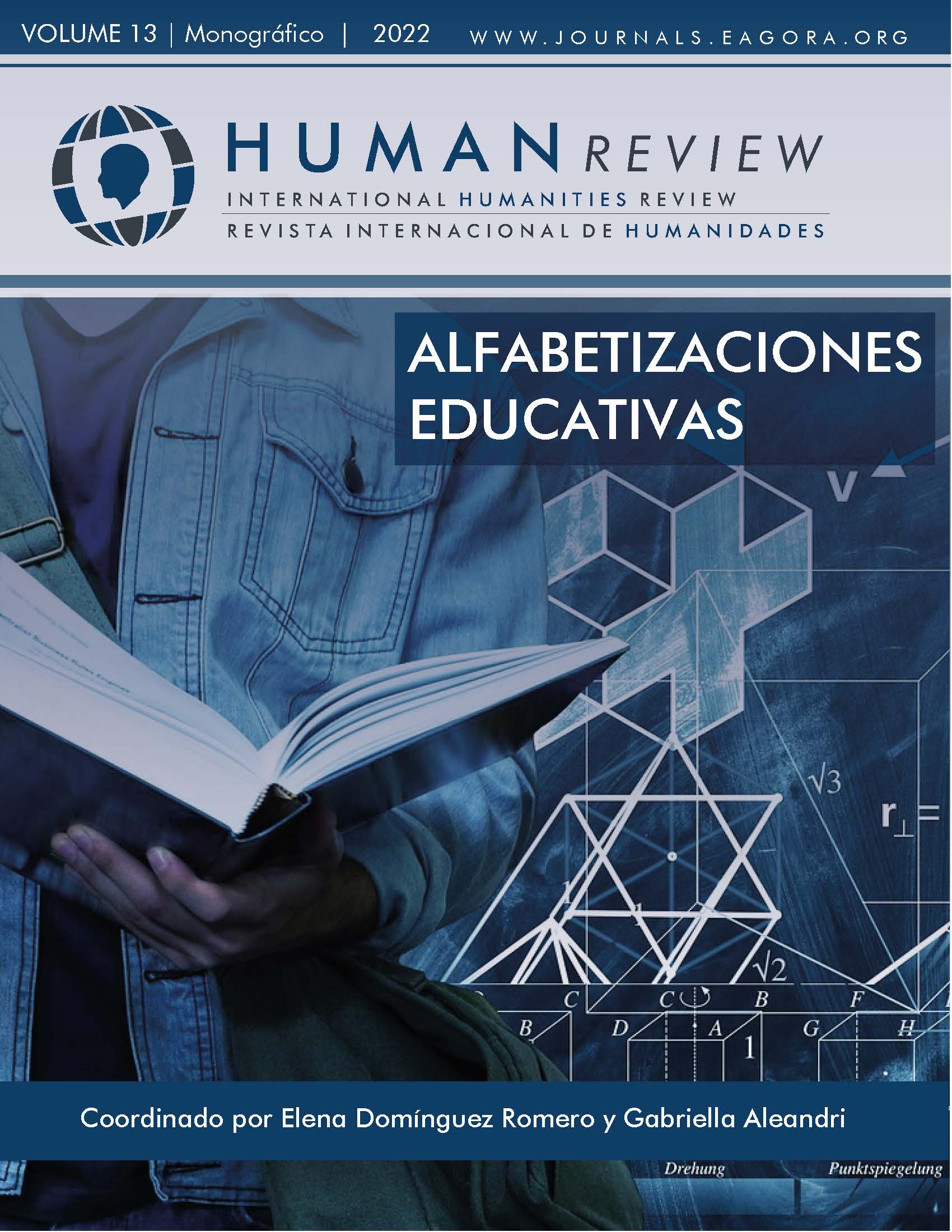Expresion, communication and self-knowledge throught the method of Painting Dialogues
Experience with students of Early Childhood Education Degree
DOI:
https://doi.org/10.37467/revhuman.v11.4280Keywords:
Art education, Gestural drawing, Dialogue, Co-creation, Learning, Cartography, Art therapyAbstract
The research presented explores the Painting Dialogues method as carried out at the University of Cádiz during the period of postdoctoral study of its creator, Małgorzata Karczmarzyk, working with Early Childhood Education students.
Building on the experience of shared creation and the joint analysis and reflection of the graphic originated by way of cartography, pictorial dialogue is revealed as a key element of the learning process,. This form of communication helps to understand and internalize knowledge, enhancing expressiveness, sensory perception, intuition, trust and listening to oneself and to the other.
References
Bauman, T., y Pilch, T. (2001). Zasady badań pedagogicznych. Wyd. Akademickie Żak. Carrasco Segovia, S., Bogarín Flores, S. y Zuñiga López, D (2019). La cartografía artística como ruta de comprensión a las intra-acciones de las experiencias investigativas, pedagógicas y artísticas. Invisibilidades Revista Ibero-Americana de Pesquisa em educacao, cultura e artes, 12, 48-58. https://www.apecv.pt/revista/invisibilidades/12/10.24981.16470508.12.7.pdf
Carrasco-Segovia, S., y Hernández-Hernández, F. (2020). Mapping affections and movements in teachers’ embodied learning. Movimento, 26(1). https://doi.org/10.22456/1982-8918.94792 DOI: https://doi.org/10.22456/1982-8918.94792
Catz de Katz, H., Flores, M., y Katz de Lanzillotta, S. (2001). La importancia del desarrollo de la técnica del garabato de Winnicott y la aplicación a la consulta terapéutica en el contexto sociocultural actual. Revista De Psicoanálisis, LVIII, 4, 953-963. http://www.fepal.org/images/congreso2002/adultos/catz_h_de_katz___garabato.pdf
Czajkowska, A. (2019). Fototerapia. Fotografia w pracy nauczyciela, pedagoga i terapeuty. Lodz University. https://wydawnictwo.uni.lodz.pl/produkt/fototerapia/
De Miguel Álvarez. L. (2015). El garabato y la “escritura dibujada” como recurso metodológico en la enseñanza del dibujo para el diseño. ArDin. Arte, Diseño e Ingeniería, 4, 11-33. https://www.ingentaconnect.com/content/doaj/22548319/2015/00000001/00000004/art00002;jsessionid=c2aio0j5kknl1.x-ic-live-01
Eco, U. (1994). Lector in fabula. Instituto de Publicaciones del Estado de Varsovia.
González-Pérez, M.A. y Mercado, P. (2014). Gerenciando la generación Y o el reto Millenials. AD-minister, 28, 7-8. https://www.redalyc.org/articulo.oa?id=322331212001
Heidegger, M. (1994). Bycie i czas. PWN.
Hernández Hernández, F. (2008). La investigación basada en las artes. propuestas para repensar la educación. Educatio Siglo XXI, 26, 85-108. https://revistas.um.es/educatio/article/view/46641
hooks, b. (1994). Enseñar a transgredir. La educación como práctica de la libertad. Capitán Swing Libros, S.L.
Jiménez, I., Vázquez, G. y Bracamontes, E. (2020). ¿Qué quieren los estudiantes universitarios? Perspectivas de las generaciones actuales. Interpretextos, 23, 131-152. http://ww.ucol.mx/interpretextos/pdfs/731_inpret2313.pdf
Kandinsky, V. (1980). De lo Espiritual en el Arte. Premia Editora.
Karczmarzyk, M. (2015). Wspólnota i u(nie)upamiętnianie. Rewizualizacje, znaczenia i strategie budowy miasta w przestrzeni Gdańska, w: Miasto jak wspólny pokój: Gdańskie modi co-vivendi. M. Mendel (red.). Instytut Kultury Miejskiej. https://sklepikm.pl/pl/p/Miasto-jak-wspolny-pokoj.-Gdanskie-modi-co-vivendi/75
Karczmarzyk, M. (2020). Metoda dialogów wizualno-werbalnych w terapii z dzieckiem niepełnosprawnym w wieku wczesnoszkolnym. Niepełnosprawność. Półrocznik naukowy, 36, 91-102.https://czasopisma.bg.ug.edu.pl/index.php/niepelnosprawnosc/article/view/5478/4814 DOI: https://doi.org/10.4467/25439561.NP.19.048.12291
Kinzbruner, G. (2004). El gesto pictórico. Pharos Arte, Ciencia y Tecnología, 11(2), 9-19. https://www.redalyc.org/pdf/208/20811203.pdf
López-Ruiz, D. y López-Martínez, M.D. (2019). Fototerapia como narrativa visual: aplicación en violencia de género. Estud. Mensaje period, 25(1), 317-334. https://revistas.ucm.es/index.php/ESMP/article/view/63731 DOI: https://doi.org/10.5209/ESMP.63731
Melosik, Z; Szkudlarek, T. (2009). Kultura tożsamość, edukacja – migotanie znaczeń. Oficyna Wydawnicza Impuls. https://www.impulsoficyna.com.pl/publikacje-naukowe/905-kultura-tozsamosc-i-edukacja.html
Morgovsky, J. (2007). Photography on the Couch: The psychological aspects uses of photography. General Psychologist, 42(1), 120-145. http://users.rider.edu/~suler/photopsy/psy%20benefits%20of%20photo.pdf
Olivares, S.A. y González, J.A. (2016). La Generación Z y los retos del docente. Los retos de la docencia ante las nuevas características de los estudiantes universitarios. Proceedings, 11, 114-124. https://www.researchgate.net/publication/327176360_La_generacion_Z_y_los_retos_del_docente
Pérez-Escoda, A., Castro-Zubizarreta, A. y Fandos-Igado, M. (2016). Digital Skill in the Z Generation: Key Questions for a Curricular Introduction in Primary School. Media Education Research Journal, 49(23), 71-79. https://www.academia.edu/29317597/Digital_Skills_in_the_Z_Generation_Key_Questions_for_a_Curricular_Introduction_in_Primary_School DOI: https://doi.org/10.3916/C49-2016-07
Rojewska-Nowak, A. (2012). Arteterapia w procesie aktywizacji osób zagrożonych wykluczeniem społecznym, Czasopismo: socjologia.pl. Wydawnictwo PROMOTOR.
Rutkowiak, J. (Ed.). (1992). Pytanie, dialog, wychowanie: praca zbiorowa. Wydawnictwo Naukowe PWN.
Soja, E. (1996). Thirdspace: Expanding the Geographical Imagination. Blackwel Publishers Inc.
Soto, A. (2022). Cuerpos atentos, espacios vividos y trazos pensantes. Cartografías de movimiento para en el aprendizaje en el áea de diseño digital y multimedia y arquitectura. ArDin. Arte, Diseño e Ingeniería, 11, 97-130. http://polired.upm.es/index.php/ardin/article/view/4804 DOI: https://doi.org/10.20868/ardin.2022.11.4804
Stern, A. (1977). La expresión. Promoción Cultural. S.A.
Suler, J. (2013). Photographoc, Psychology: Image and Psyche. Rider University.
Weiser, J. (1999). Techiniki Foto/Terapii w doradztwie i terapii – materiały warsztatowe. Hanford, fuente no publicada.
Weber, S. y Mitchell, C. (2004) About Art-Based Research . Extractos de Visual Artistic Modes of Representation for Self-Study. International Handbook of Self-Study of Teaching and Teacher Education Practices.
Downloads
Published
How to Cite
Issue
Section
License
Those authors who publish in this journal accept the following terms:
- Authors will keep the moral right of the work and they will transfer the commercial rights.
- After 1 year from publication, the work shall thereafter be open access online on our website, but will retain copyright.
- In the event that the authors wish to assign an Creative Commons (CC) license, they may request it by writing to publishing@eagora.org









